Abstract
1. The threshold of the discharge from single ganglion cells in the excised and opened frog's eye has been measured with on/off stimuli and test parameters that make it possible to activate the rhodopsin rods only. The test stimuli have been restricted to the central part of the receptive field, where no nervous reorganization can be observed with changes in the state of adaptation.
2. When such thresholds and the intensities of the background lights are expressed in terms of the number of quanta absorbed per unit time, it is found that three factors can be correlated with the thresholds measured in various states of light- and dark-adaptation: (i) the intensity of a steady background, (ii) the rate of regeneration of rhodopsin, and (iii) the amount of metarhodopsin II present in the rods.
3. The threshold is found to be proportional both to the intensity of a background and to the rate of regeneration, whereas there is a linear relationship between the logarithm of the threshold and the amount of metarhodopsin II.
4. The presence of metarhodopsin elevates all thresholds, the absolute threshold, increment thresholds and the thresholds elevated by regenerating rhodopsin in the same way.
5. The saturation of the rods at high background intensities is found to be correlated with the accumulation of significant amounts of metarhodopsin in the rods, caused by the bleaching effect of the background.
6. The effect of metarhodopsin on the threshold is independent of the amount of rhodopsin present in the rods.
7. The combined effect of all three factors can be expressed in a general formula, given as eqn. (7) on p. 74.
8. A background not only reduces the signals from the rods illuminated, but also those from neighbouring unilluminated rods. This effect is rapidly decreased with increasing distance from rods covered by the background. This kind of lateral spread in the retina probably occurs also when the rate of regeneration affects the threshold. The effect of metarhodopsin, on the other hand, appears restricted to those receptors that contain this substance.
Full text
PDF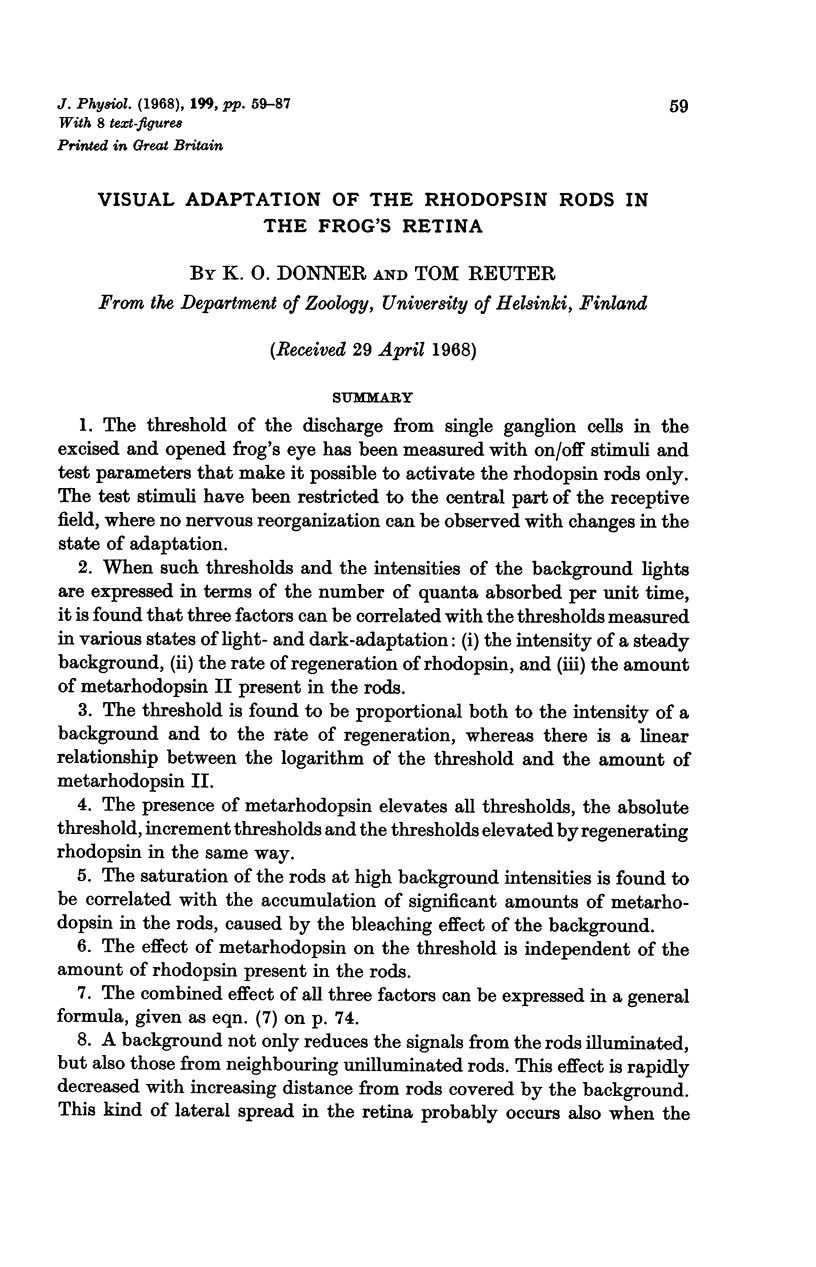
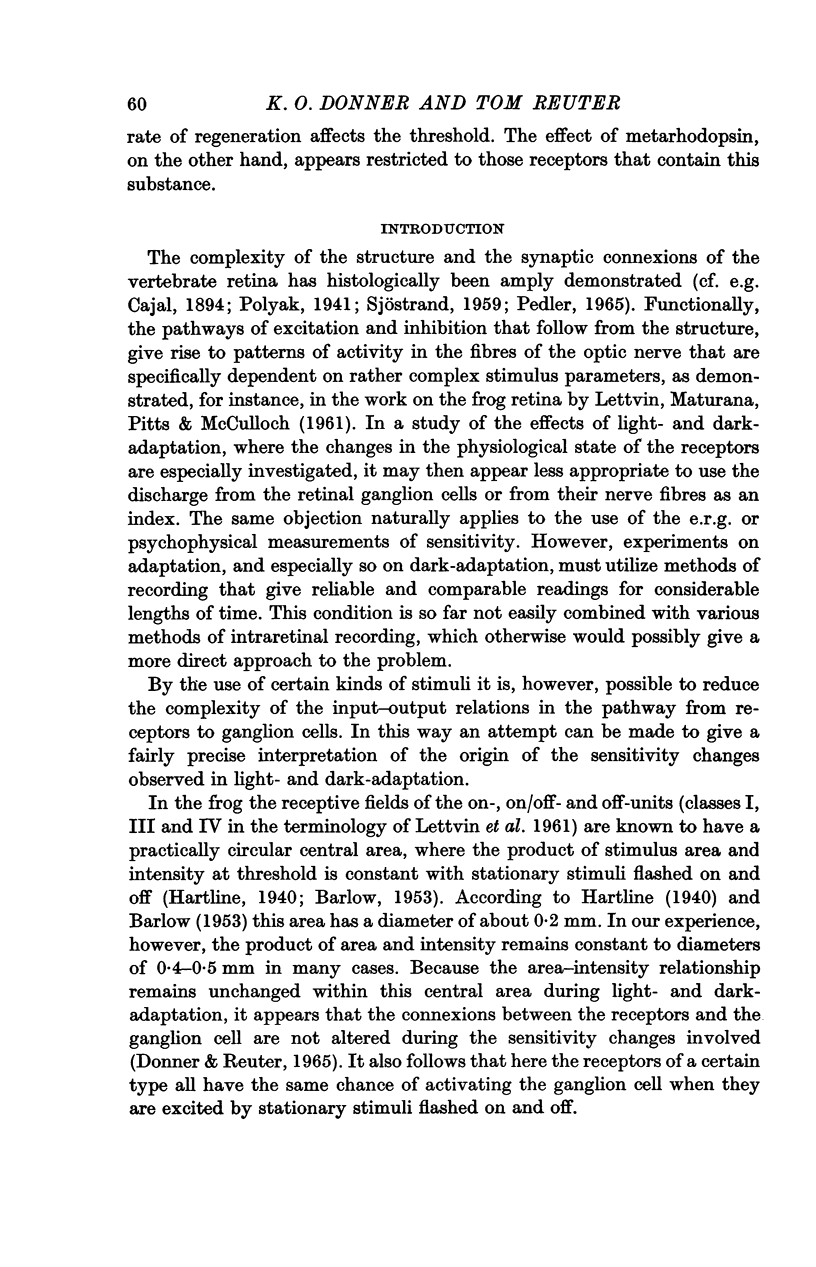
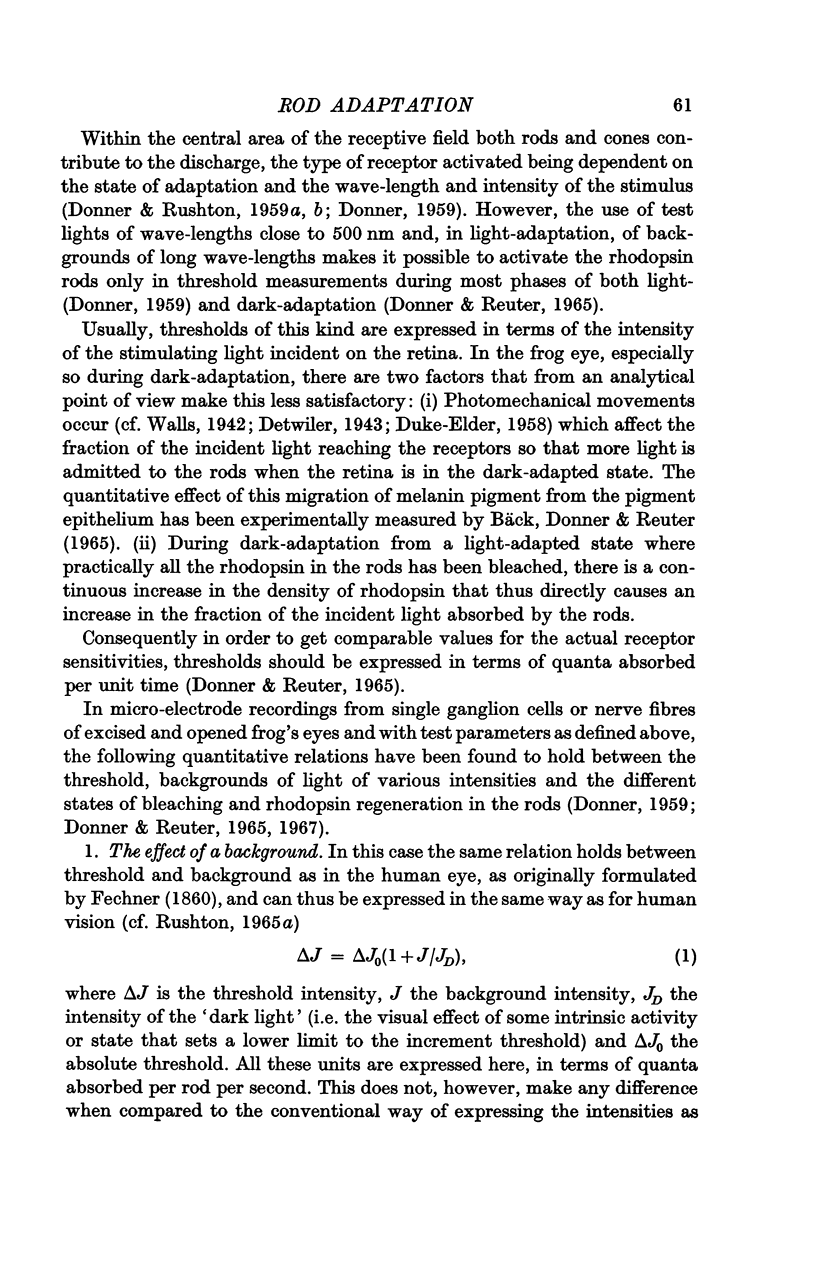
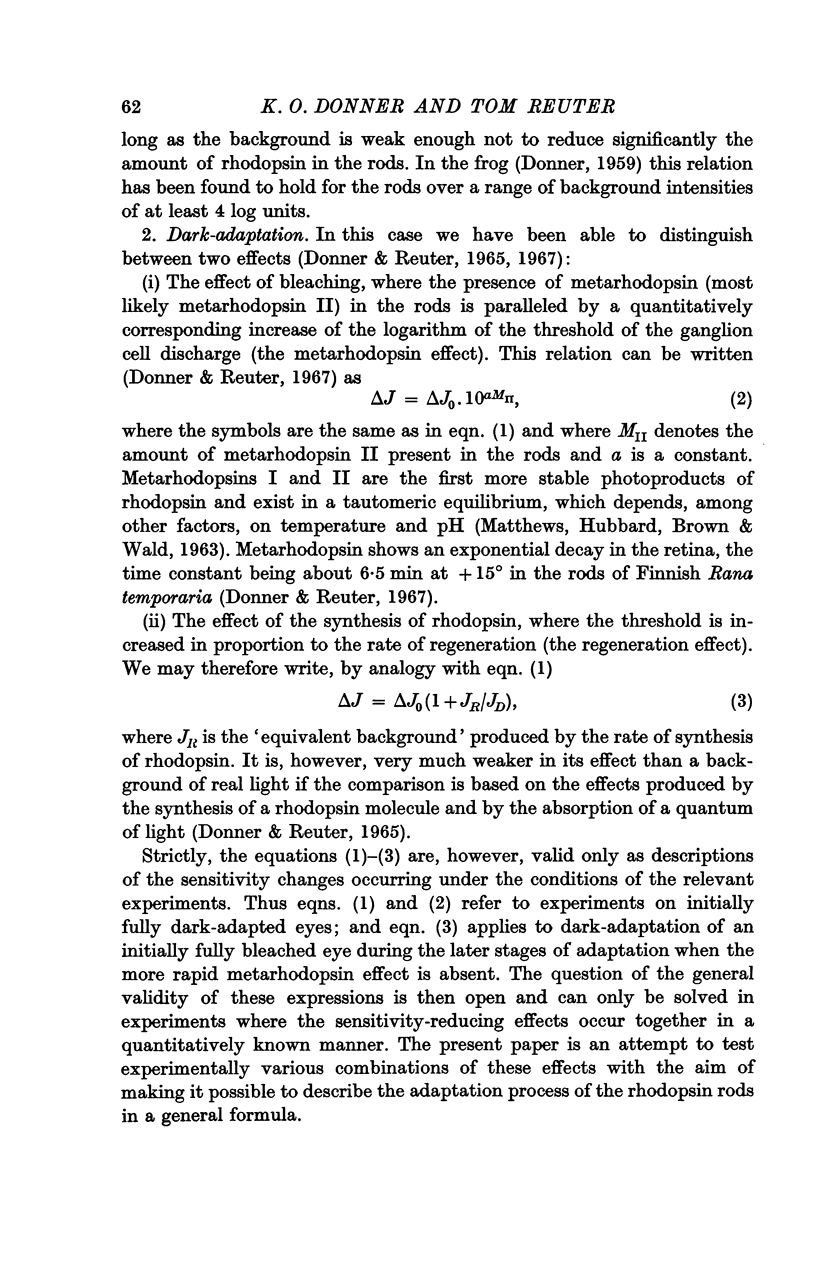
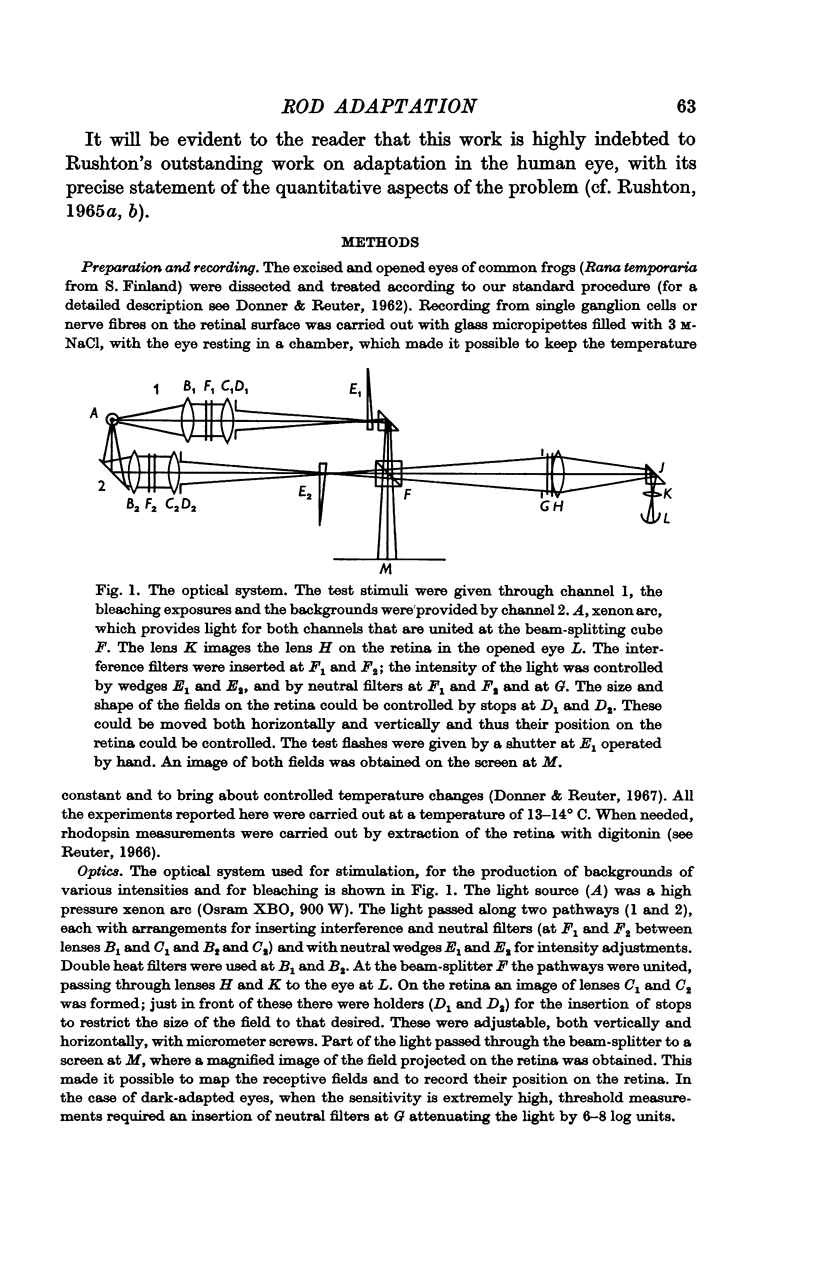
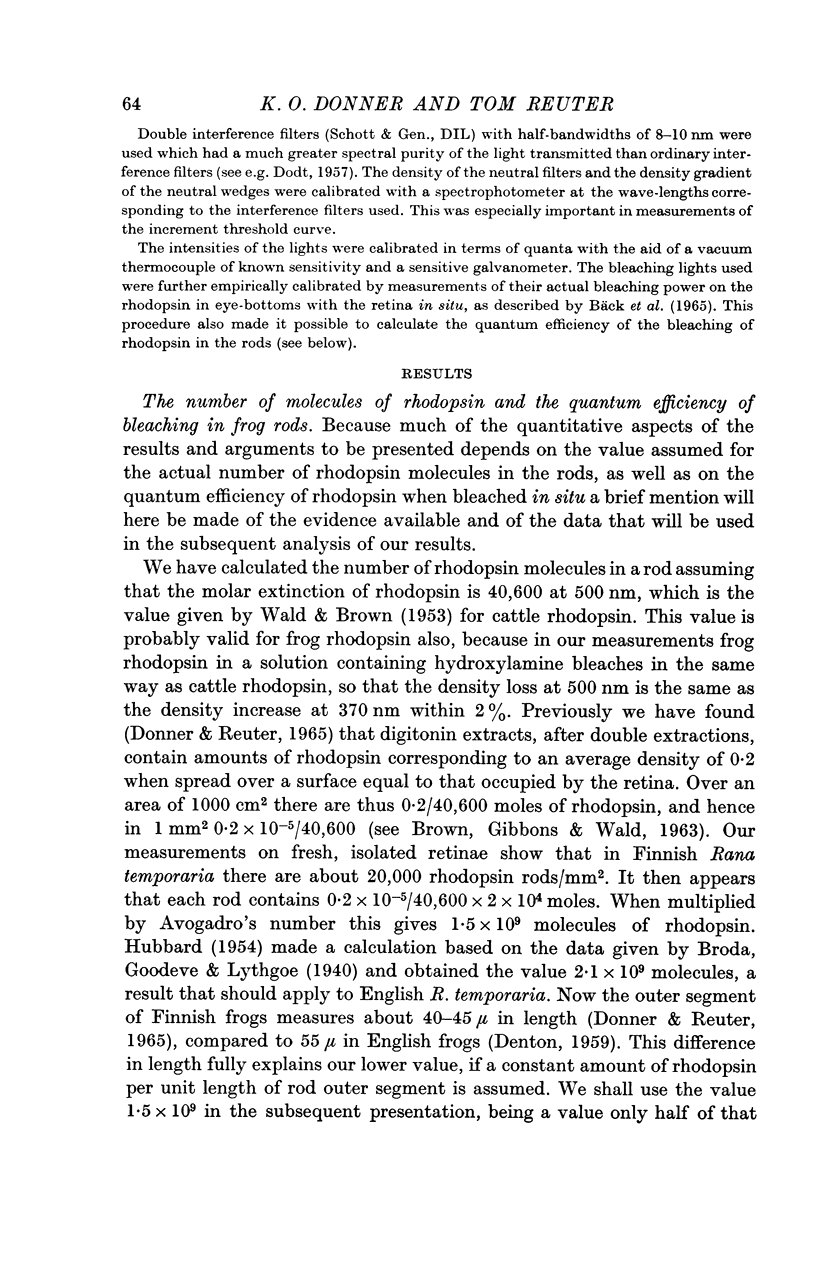
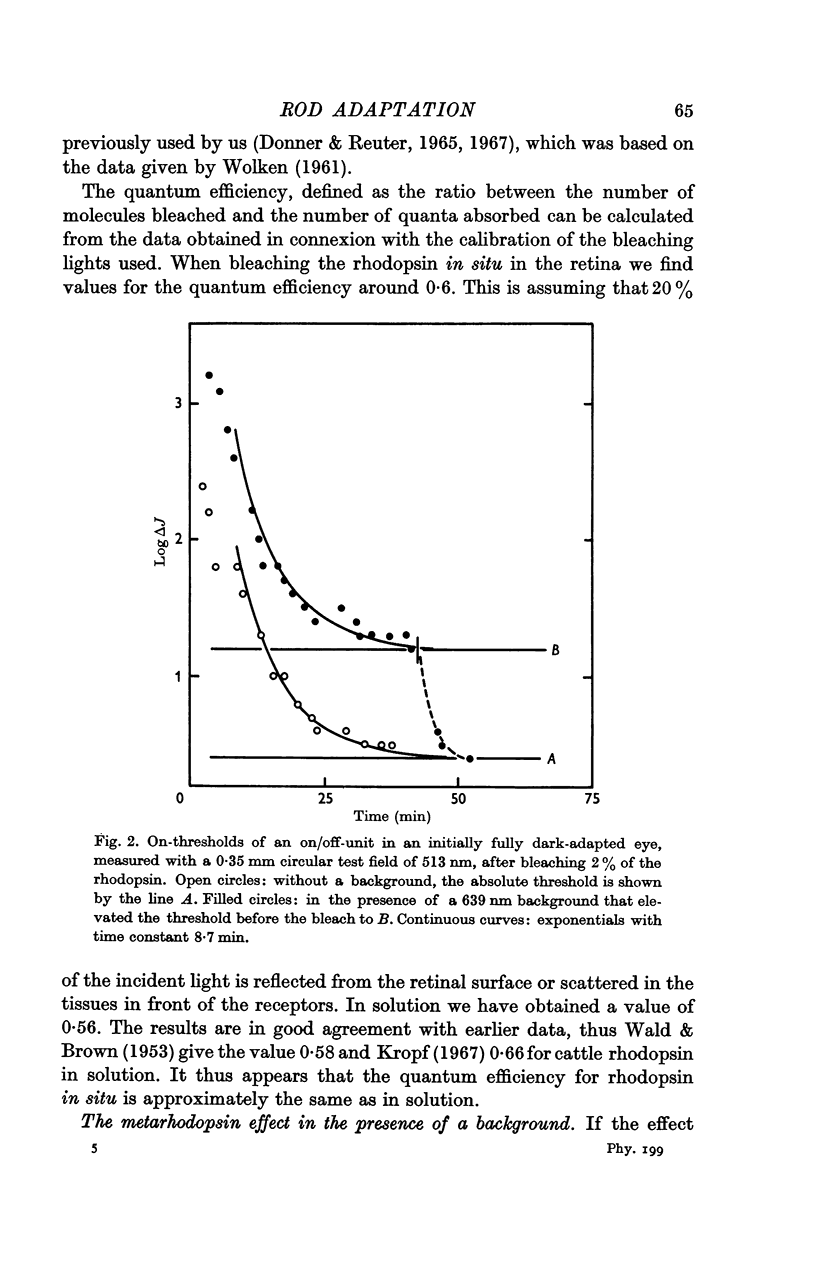
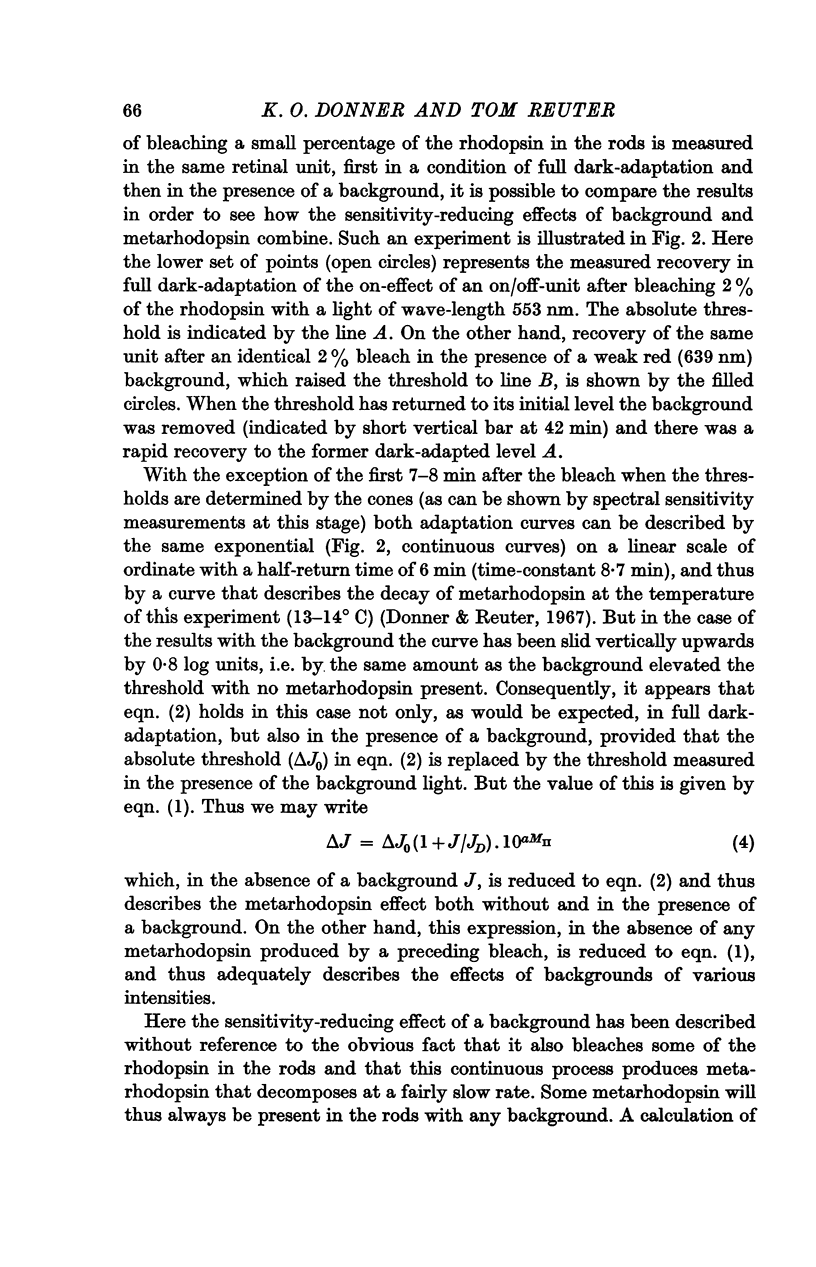
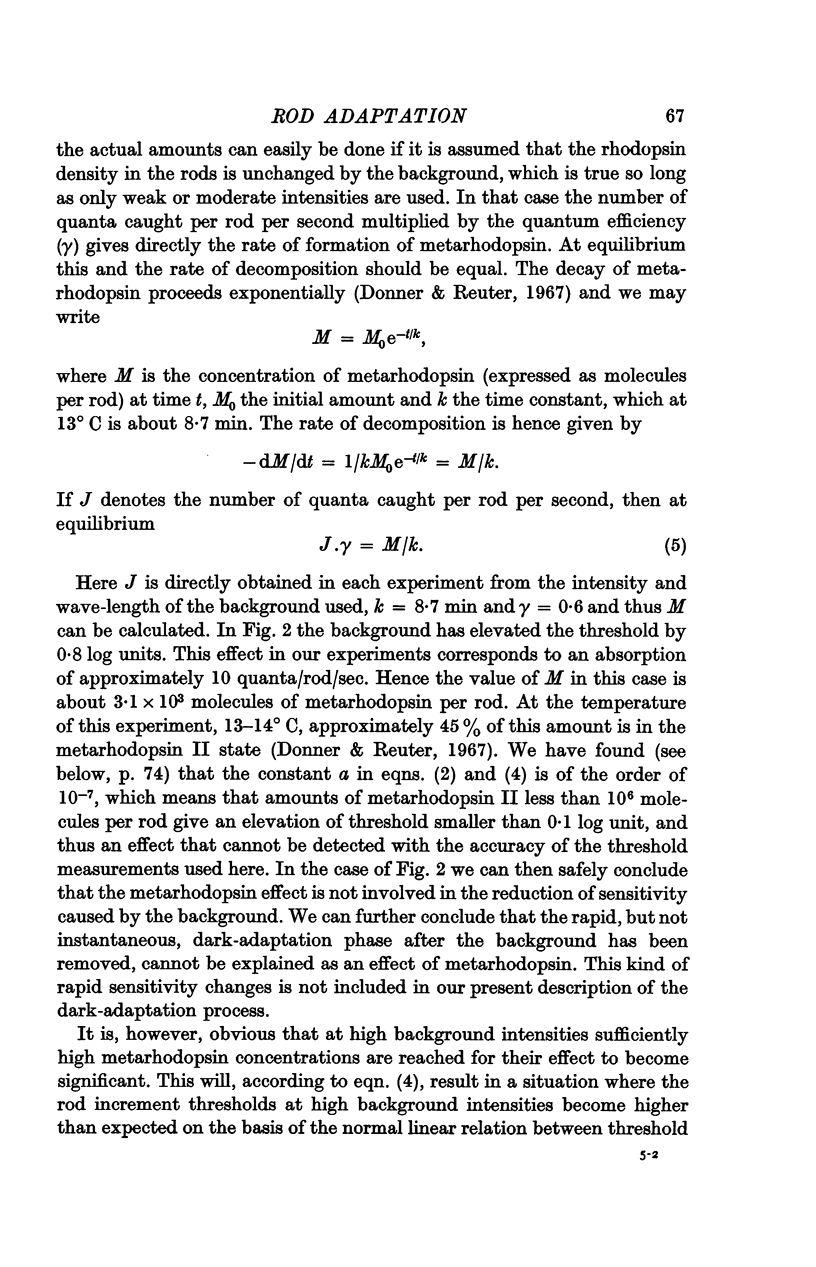
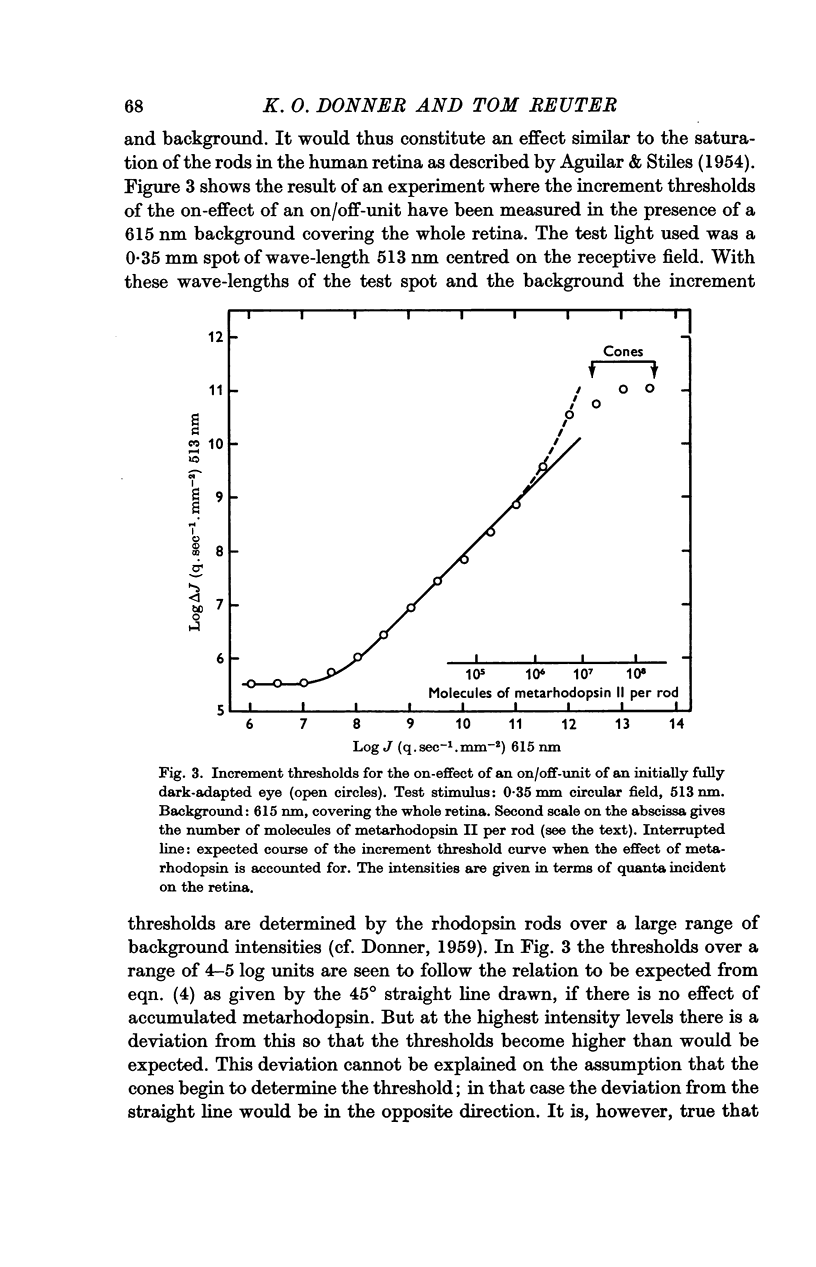
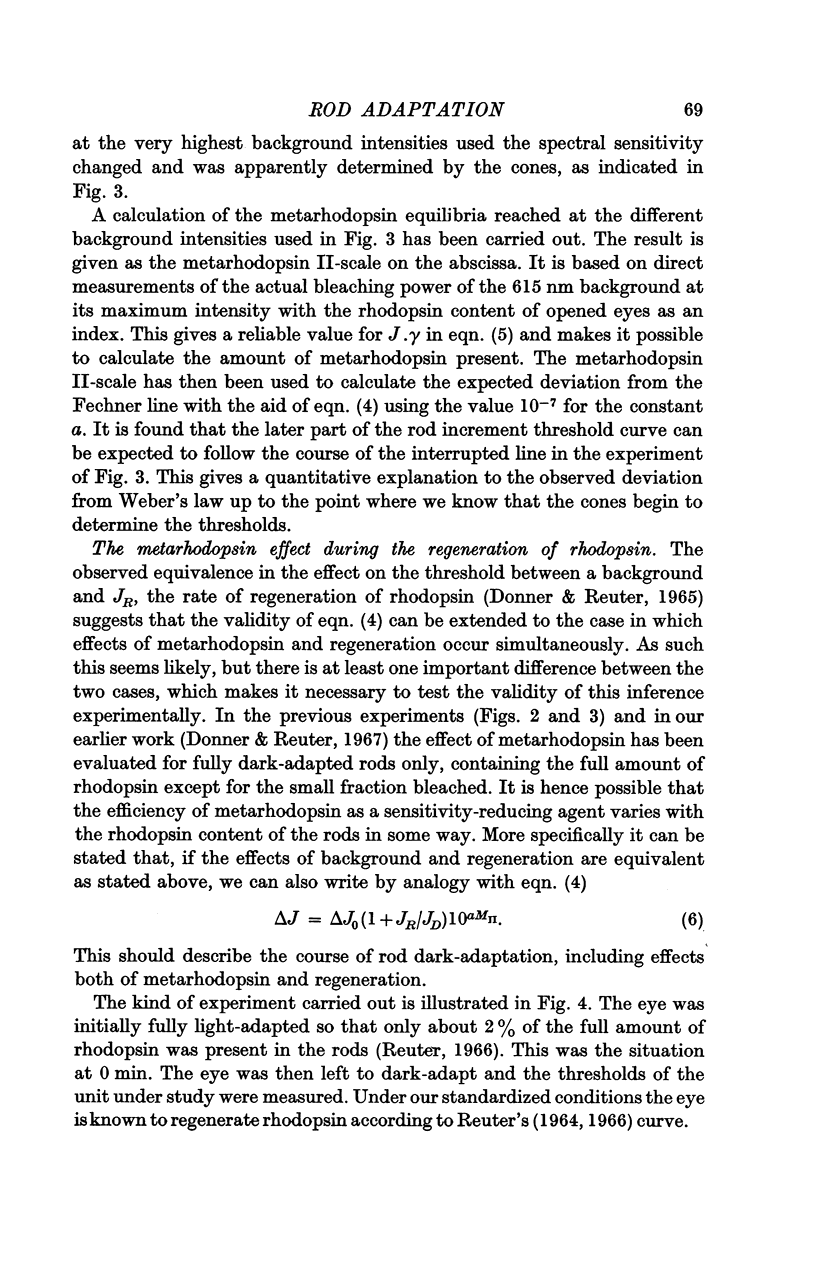
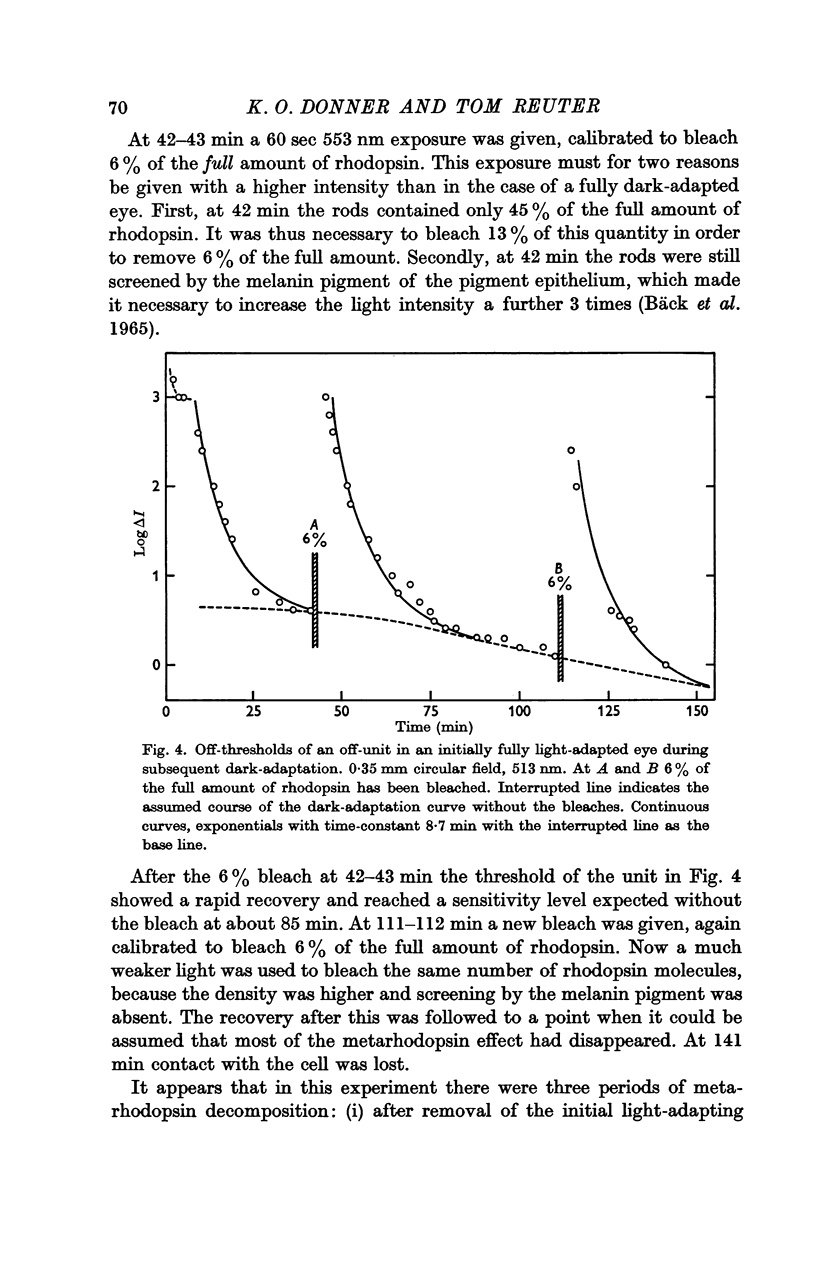
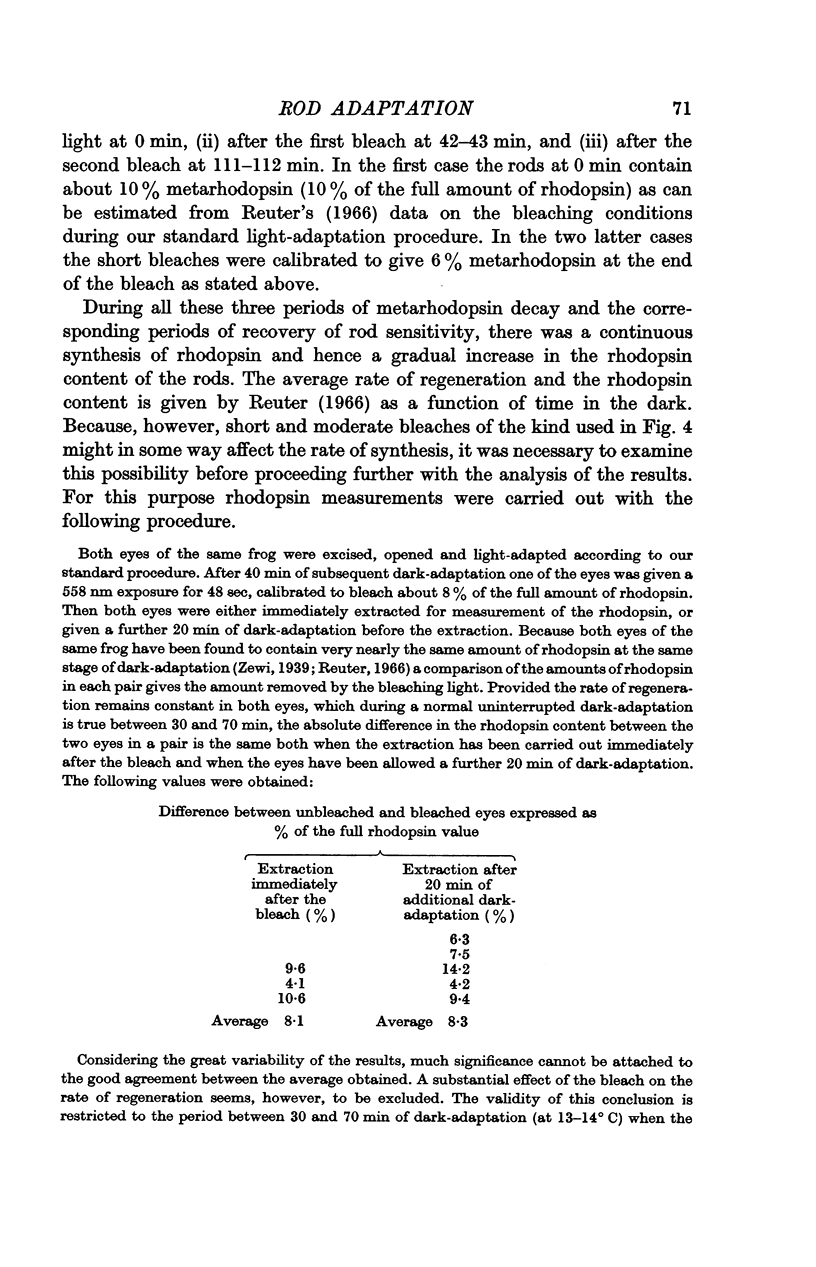
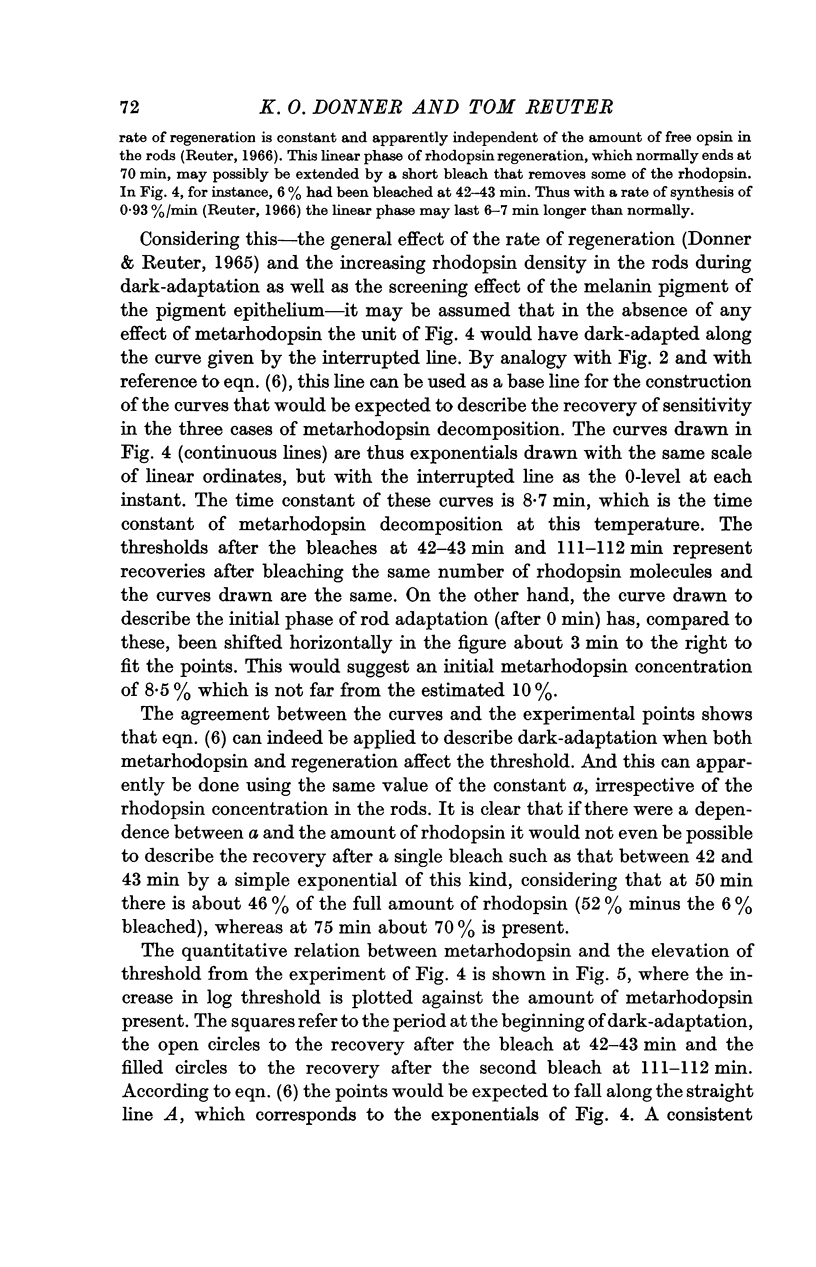
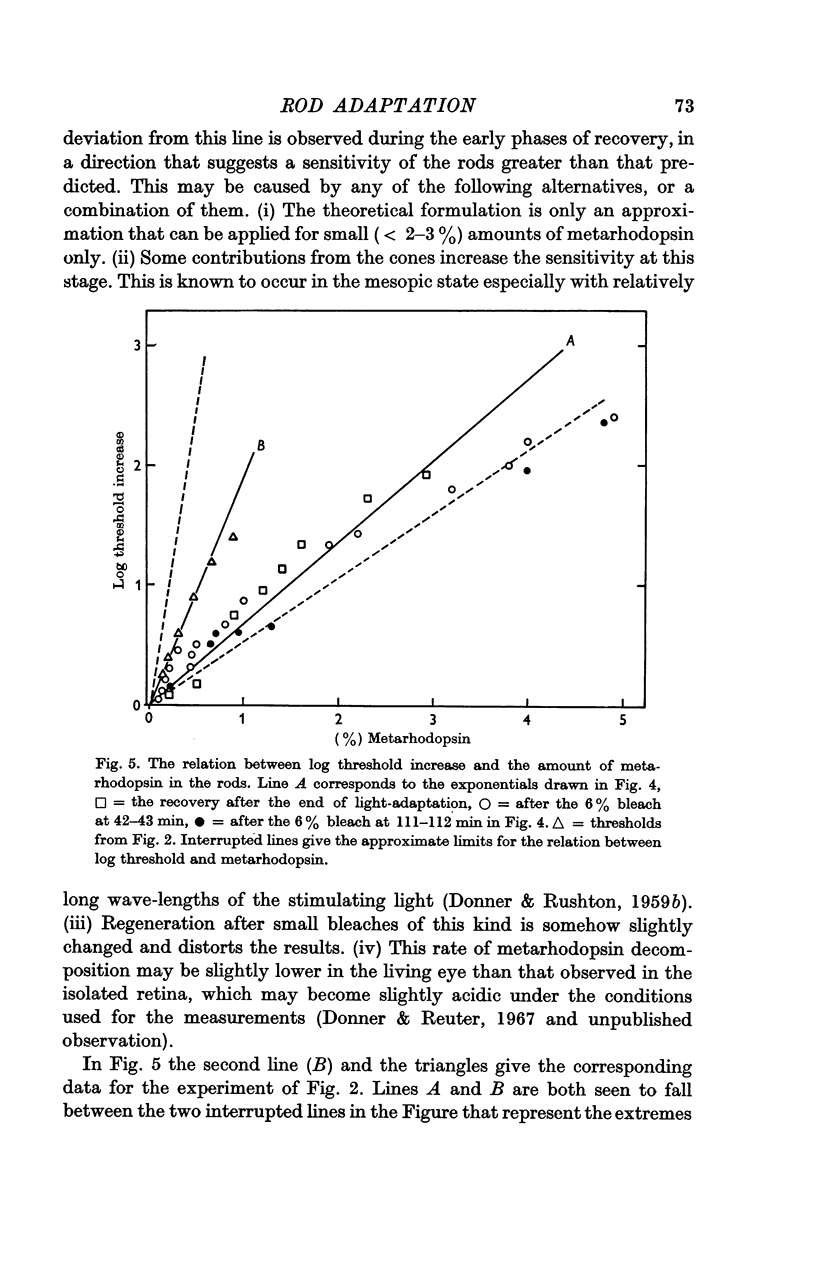
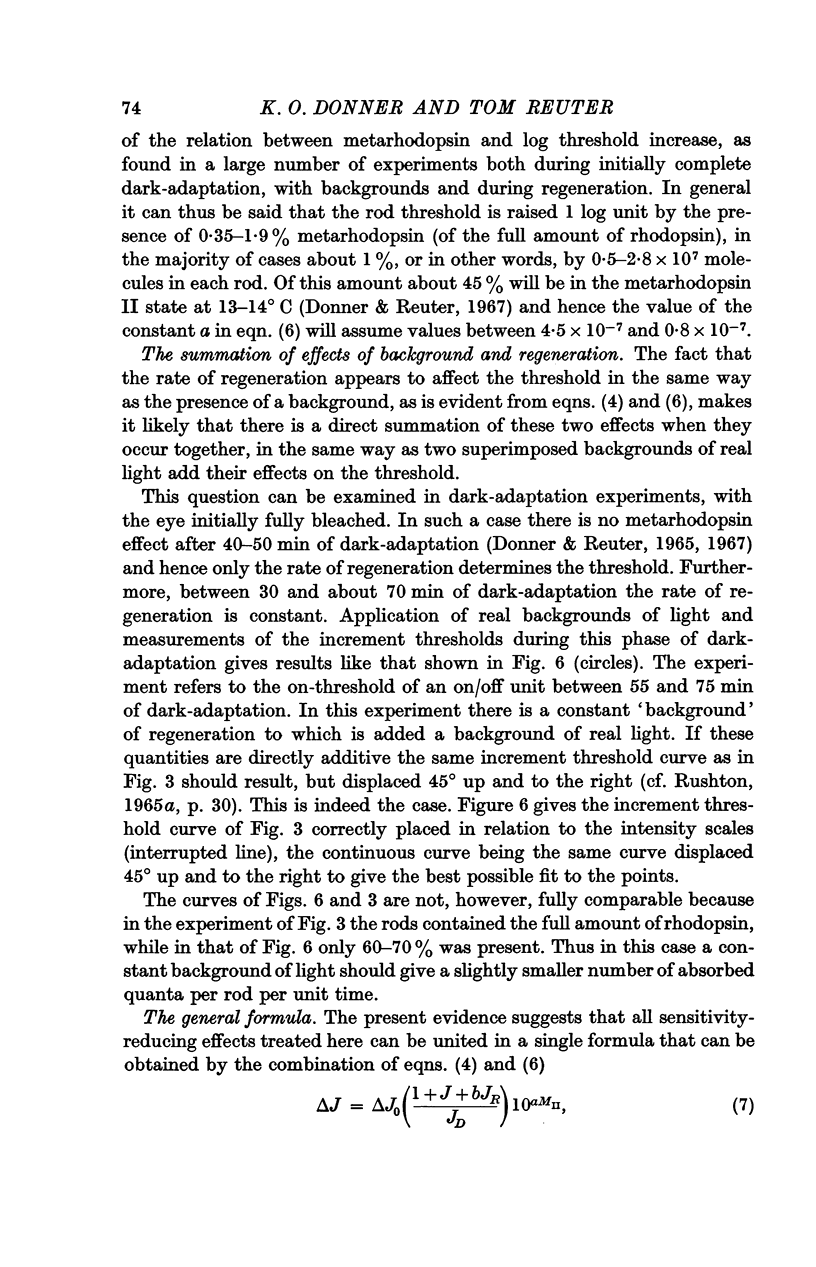
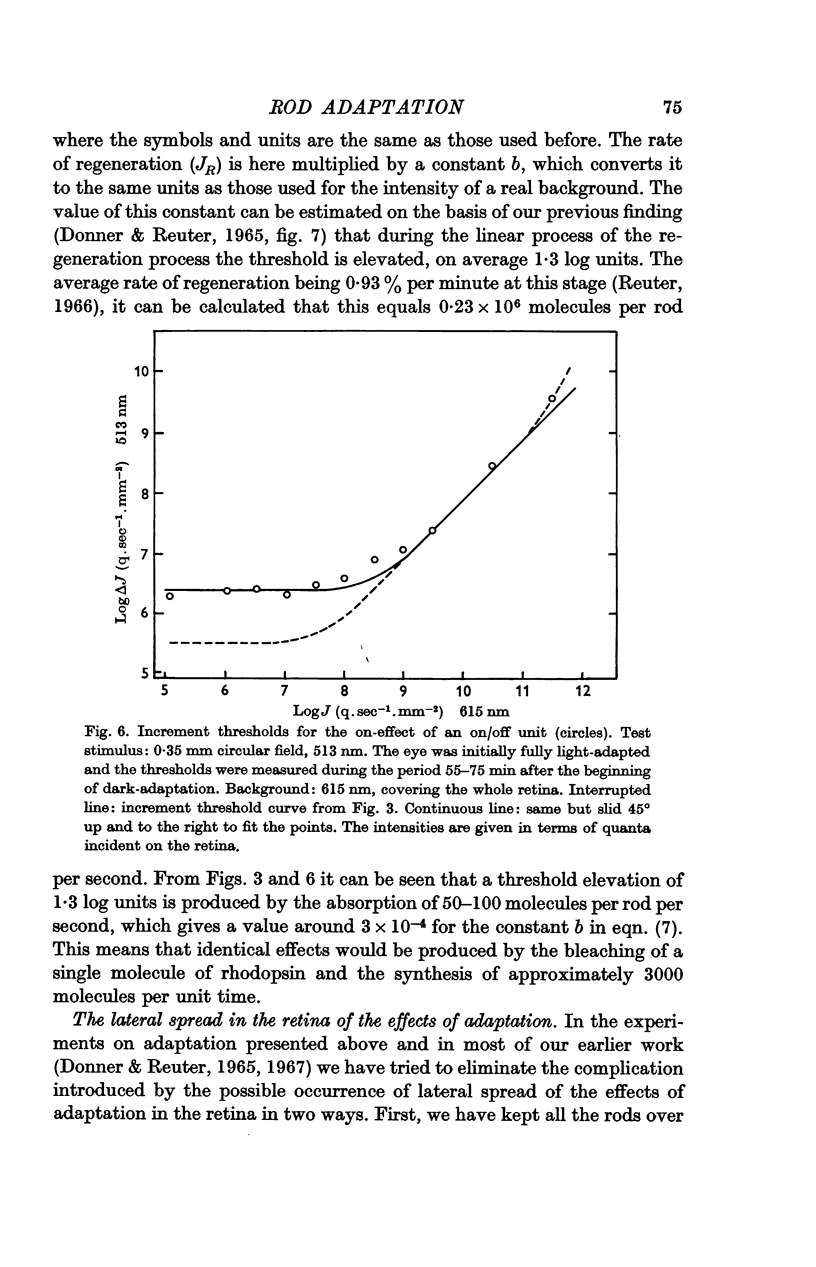
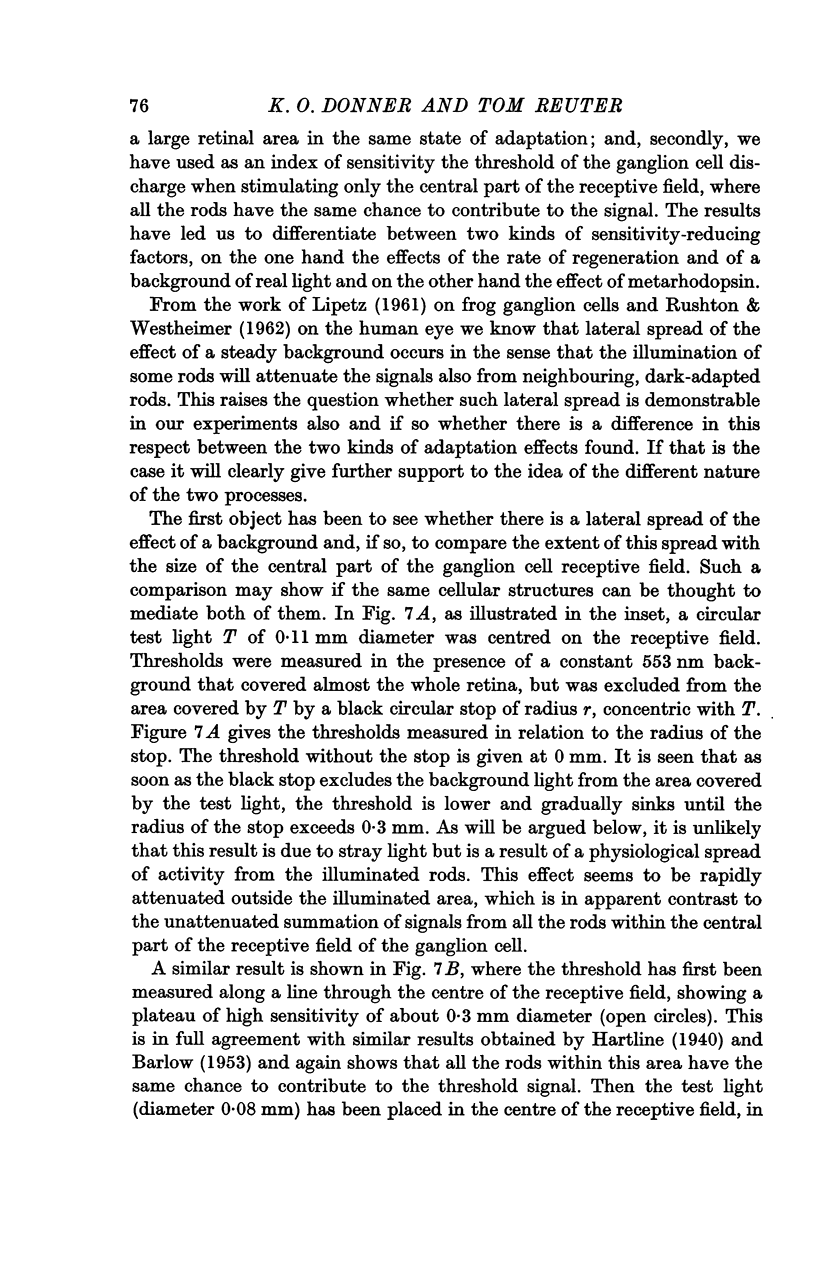
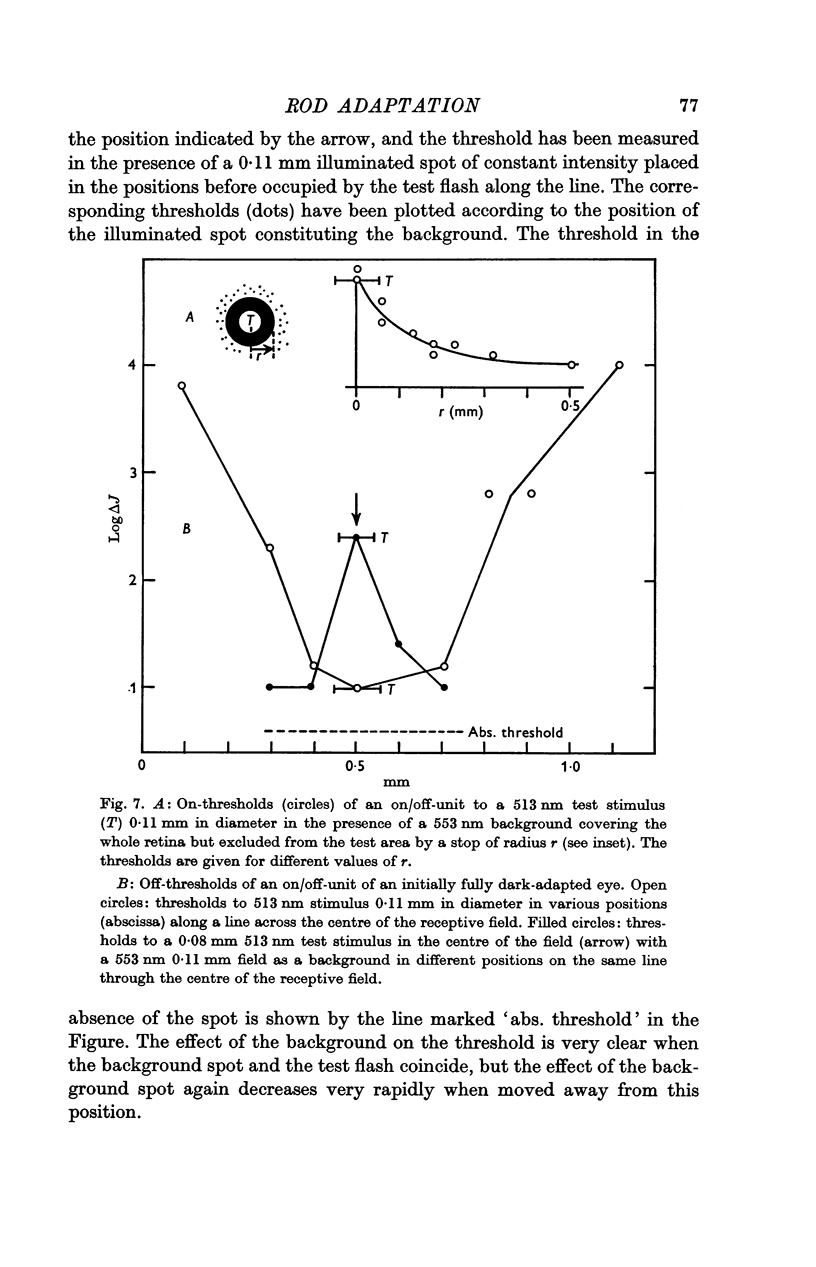
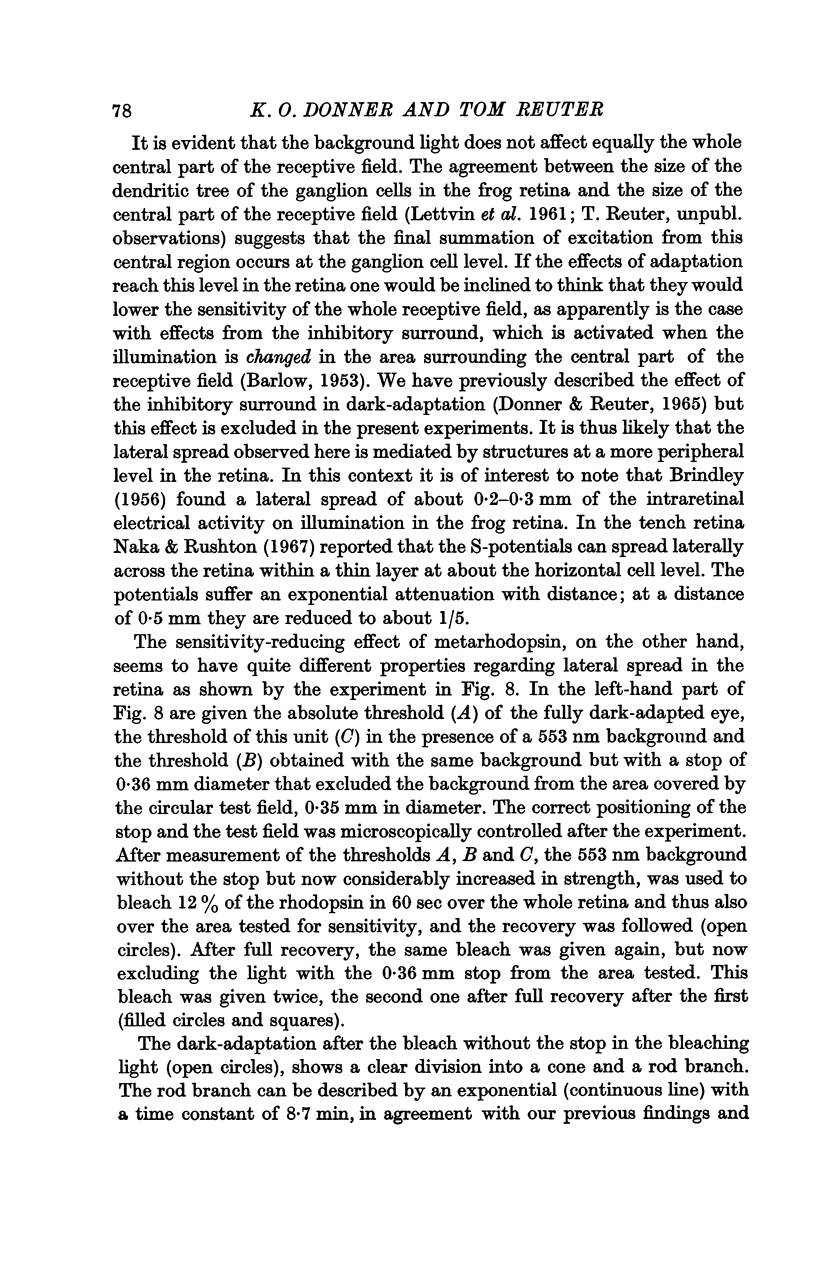
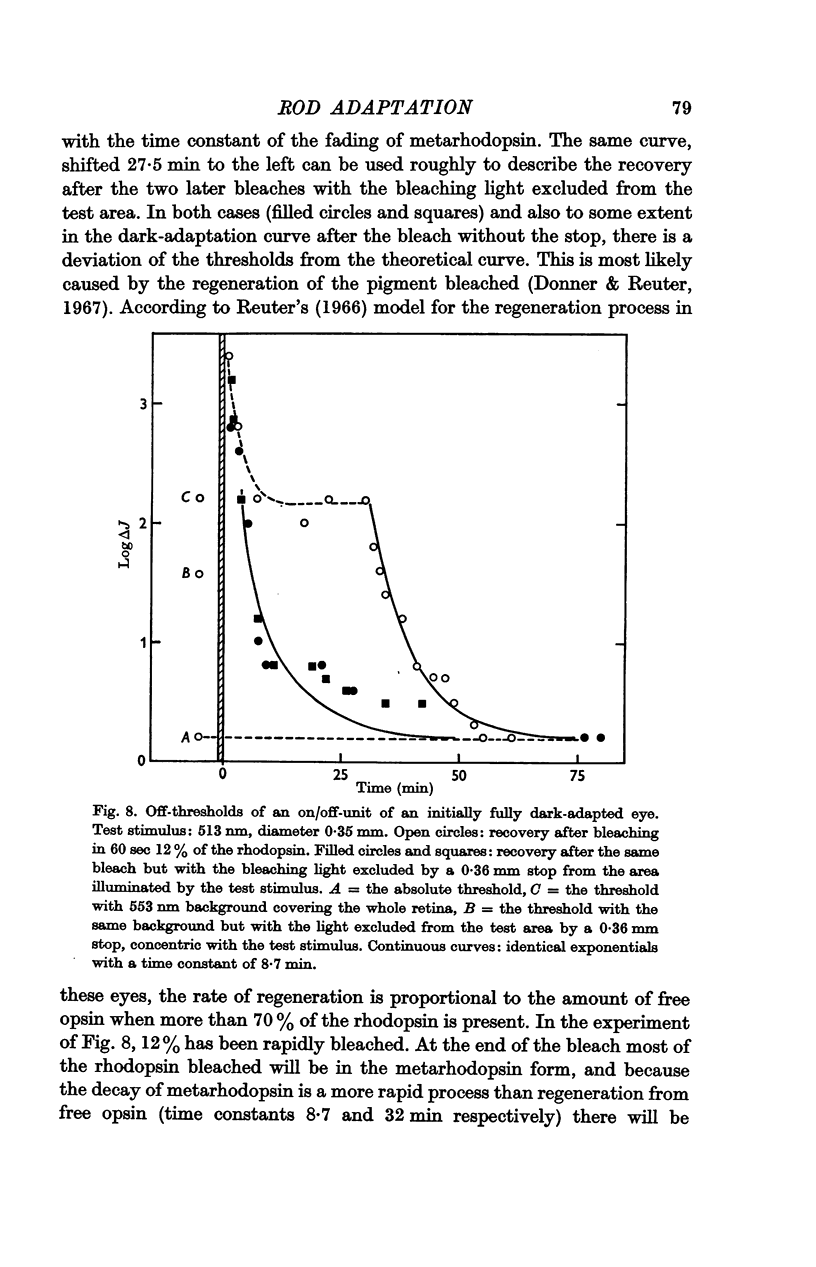
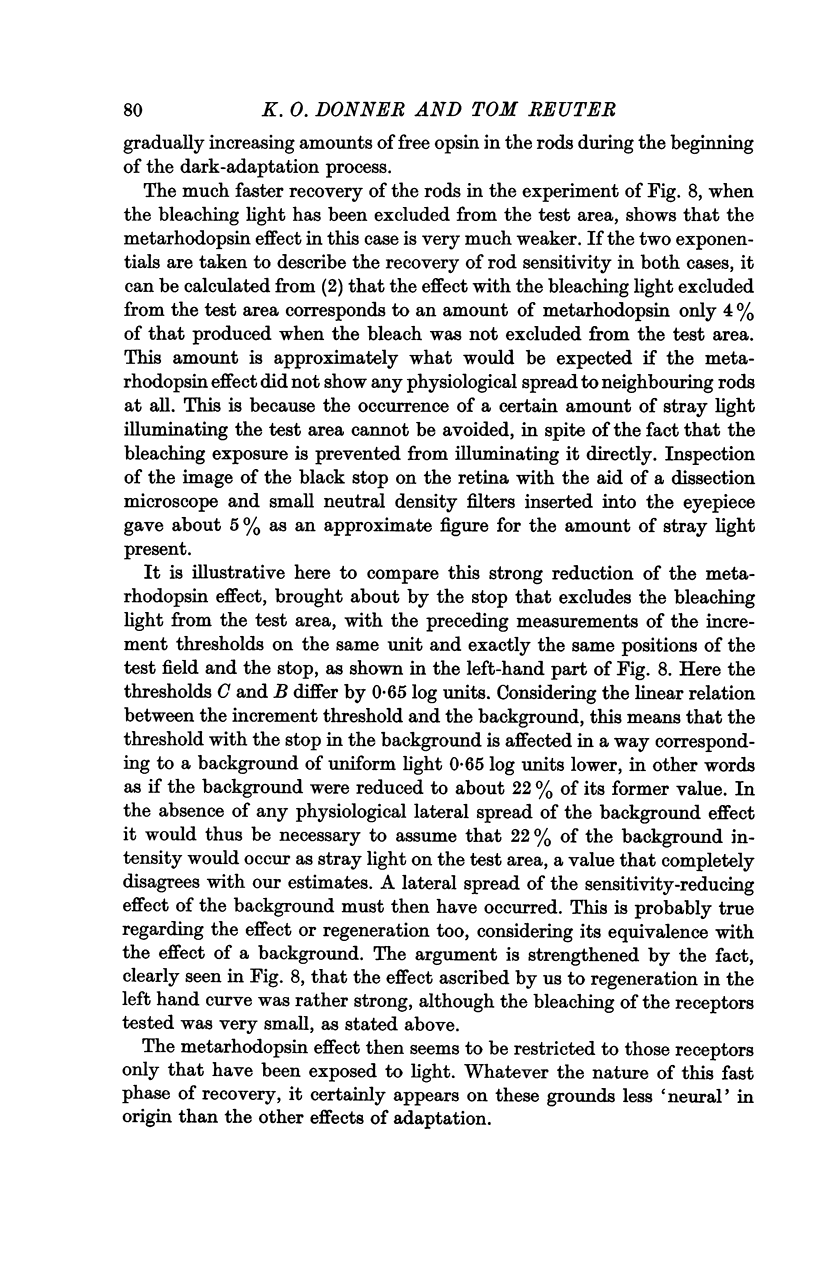
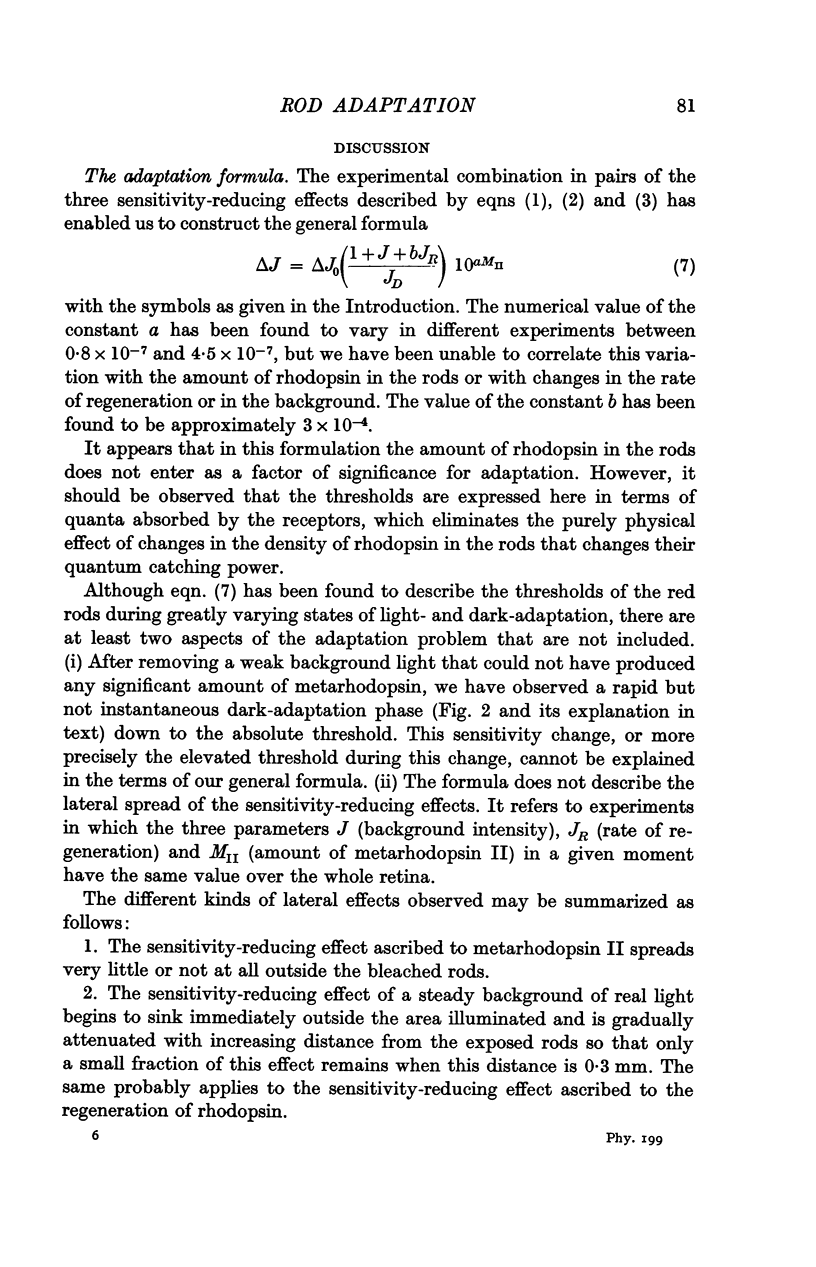
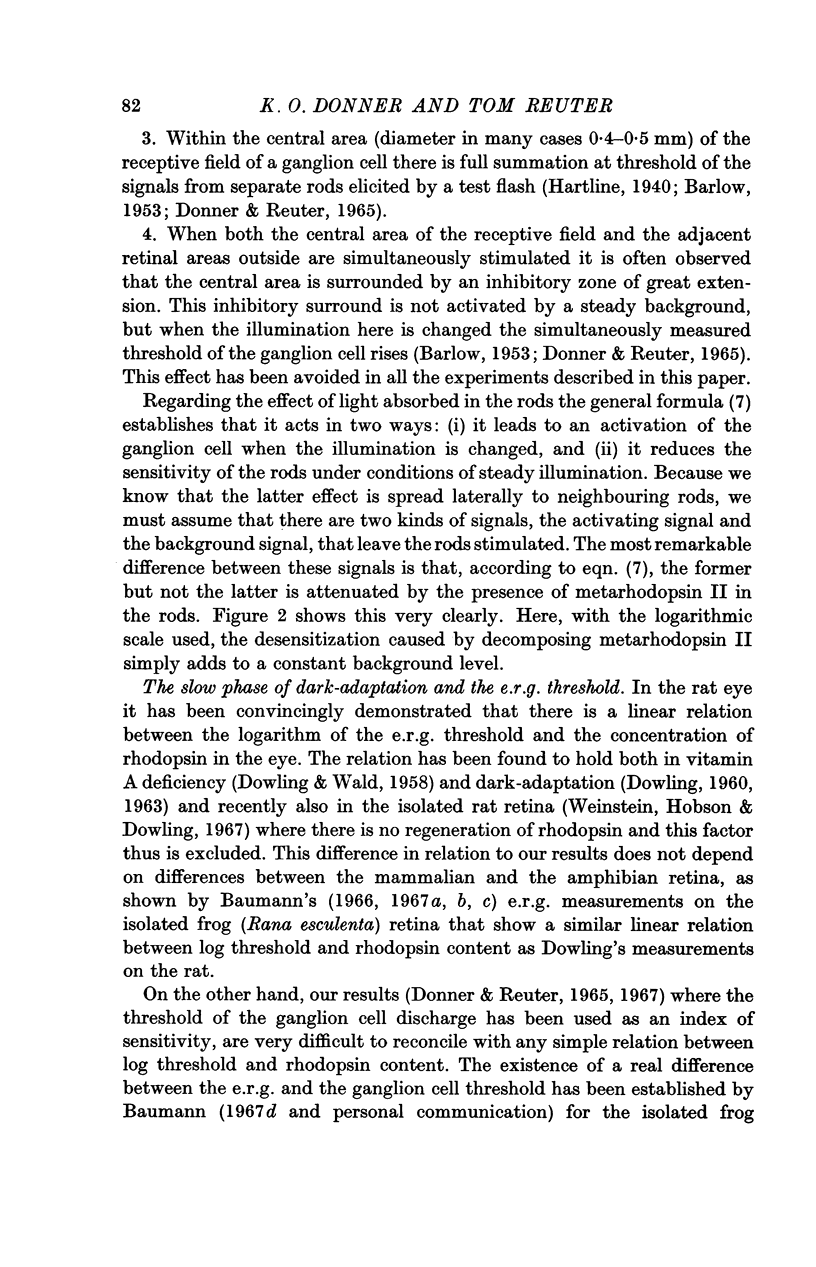
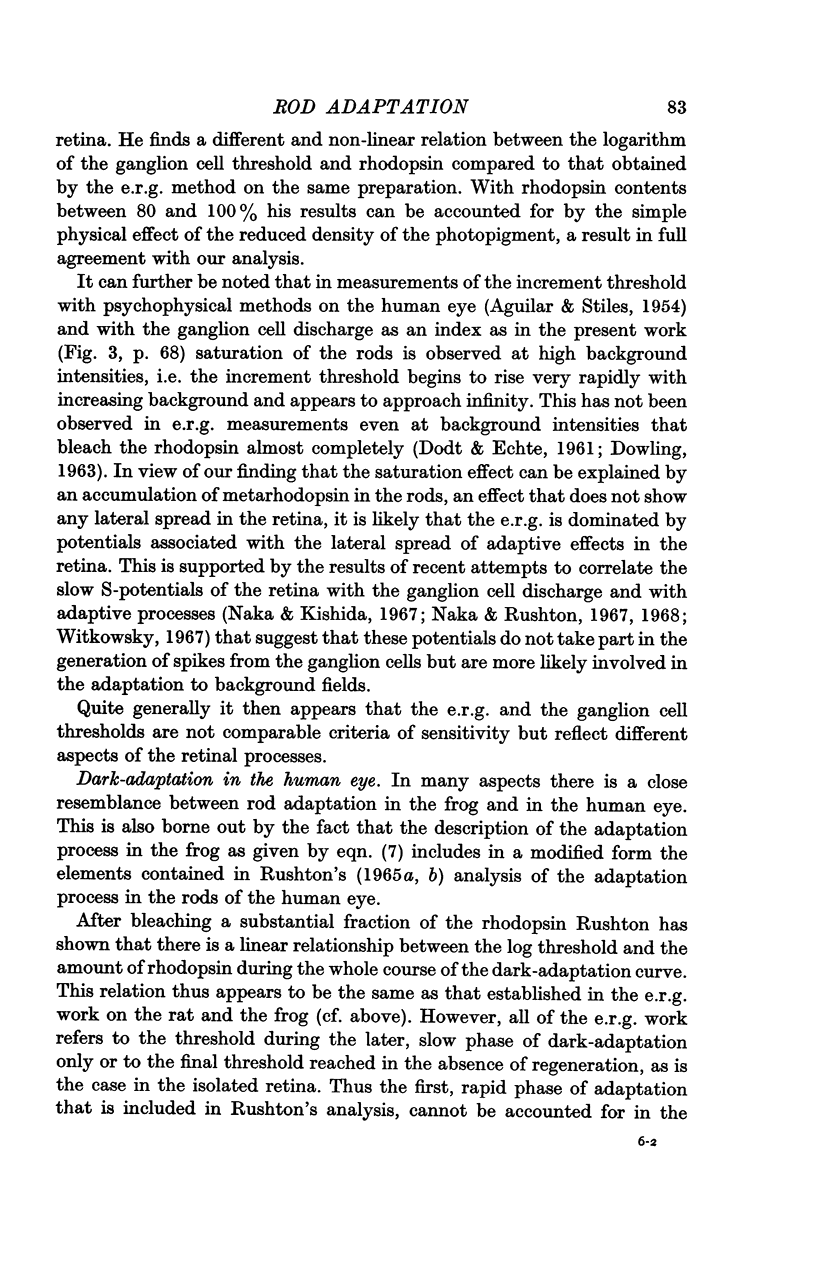
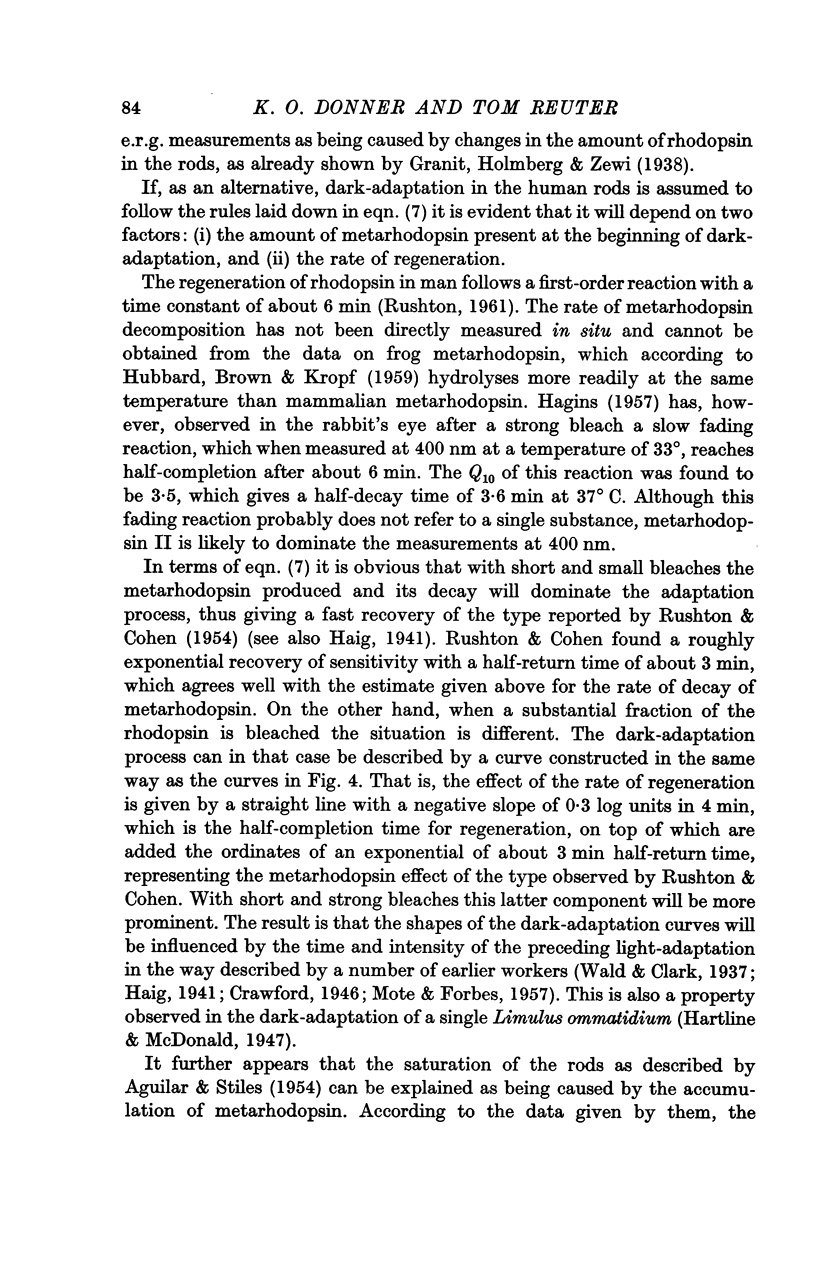
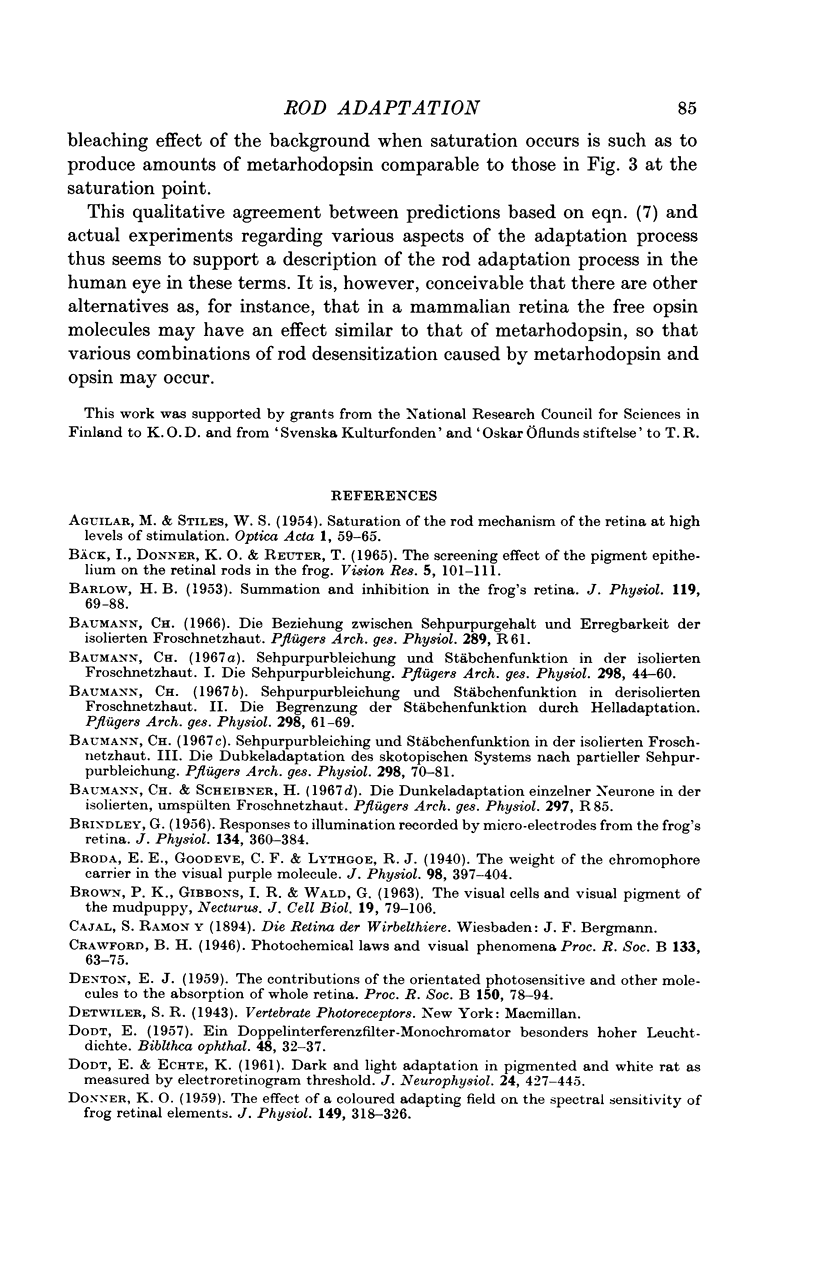
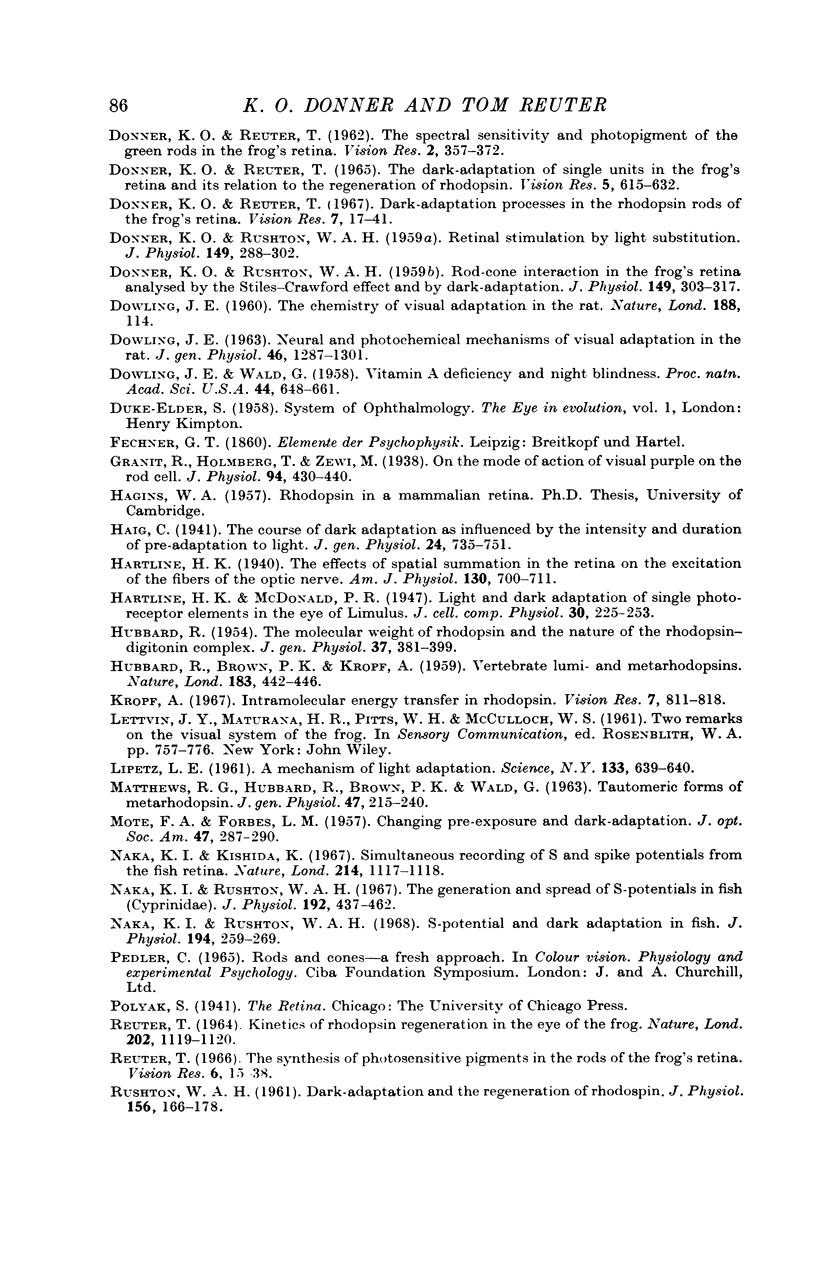
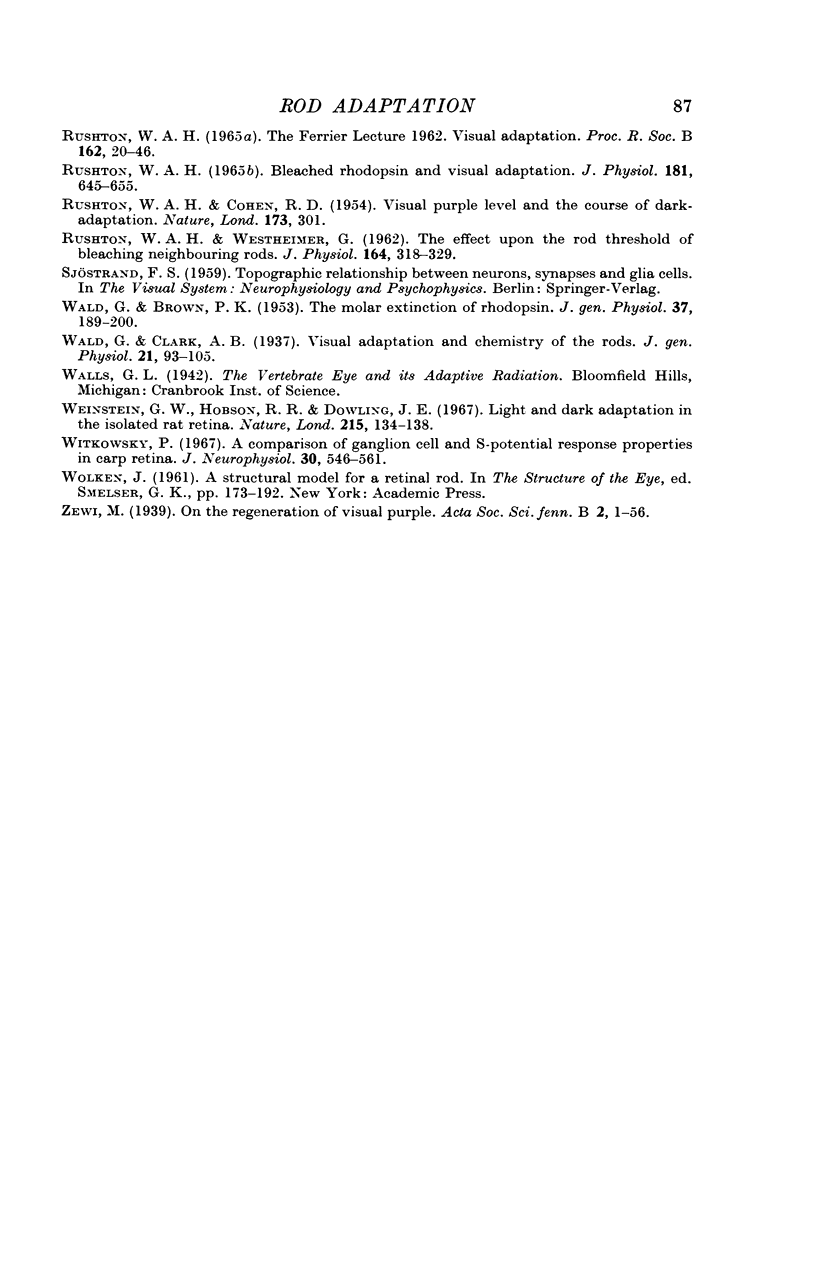
Selected References
These references are in PubMed. This may not be the complete list of references from this article.
- BARLOW H. B. Summation and inhibition in the frog's retina. J Physiol. 1953 Jan;119(1):69–88. doi: 10.1113/jphysiol.1953.sp004829. [DOI] [PMC free article] [PubMed] [Google Scholar]
- BRINDLEY G. S. Responses to illumination recorded by microelectrodes from the frog's retina. J Physiol. 1956 Nov 28;134(2):360–384. doi: 10.1113/jphysiol.1956.sp005649. [DOI] [PMC free article] [PubMed] [Google Scholar]
- BROWN P. K., GIBBONS I. R., WALD G. THE VISUAL CELLS AND VISUAL PIGMENT OF THE MUDPUPPY, NECTURUS. J Cell Biol. 1963 Oct;19:79–106. doi: 10.1083/jcb.19.1.79. [DOI] [PMC free article] [PubMed] [Google Scholar]
- Baumann C. Sehpurpurbleichung und Stäbchenfunktion in der isolierten Froschndtzhaut. 3. Die Dunkeladaptation des skotopischen Systems nach partieller Sehpurpurbleichung. Pflugers Arch Gesamte Physiol Menschen Tiere. 1967;298(1):70–81. [PubMed] [Google Scholar]
- Baumann C. Sehpurpurbleichung und Stäbchenfunktion in der isolierten Froschnetzhaut. I. Die Sehpurpurbleichung. Pflugers Arch Gesamte Physiol Menschen Tiere. 1967;298(1):44–60. [PubMed] [Google Scholar]
- Broda E. E., Goodeve C. F., Lythgoe R. J. The weight of the chromophore carrier in the visual purple molecule. J Physiol. 1940 Sep 14;98(4):397–404. doi: 10.1113/jphysiol.1940.sp003857. [DOI] [PMC free article] [PubMed] [Google Scholar]
- Bäck I., Donner K. O., Reuter T. The screening effect of the pigment epithelium on the retinal rods in the frog. Vision Res. 1965 Apr;5(3):101–111. doi: 10.1016/0042-6989(65)90058-1. [DOI] [PubMed] [Google Scholar]
- DENTON E. J. The contributions of the orientated photosensitive and other molecules to the absorption of whole retina. Proc R Soc Lond B Biol Sci. 1959 Jan 27;150(938):78–94. doi: 10.1098/rspb.1959.0009. [DOI] [PubMed] [Google Scholar]
- DODT E., ECHTE K. Dark and light adaptation in pigmented and white rat as measured by electroretinogram threshold. J Neurophysiol. 1961 Jul;24:427–445. doi: 10.1152/jn.1961.24.4.427. [DOI] [PubMed] [Google Scholar]
- DODT E. Ein Doppelinterferenzfilter-Monochromator besonders hoher Leucht-dichte. Bibl Ophthalmol. 1957;(48):32–37. [PubMed] [Google Scholar]
- DONNER K. O., RUSHTON W. A. Retinal stimulation by light substitution. J Physiol. 1959 Dec;149:288–302. doi: 10.1113/jphysiol.1959.sp006340. [DOI] [PMC free article] [PubMed] [Google Scholar]
- DONNER K. O., RUSHTON W. A. Rod-cone interaction in the frog's retina analysed by the Stiles-Crawford effect and by dark adaptation. J Physiol. 1959 Dec;149:303–317. doi: 10.1113/jphysiol.1959.sp006341. [DOI] [PMC free article] [PubMed] [Google Scholar]
- DONNER K. O. The effect of a coloured adapting field on the spectral sensitivity of frog retinal elements. J Physiol. 1959 Dec;149:318–326. doi: 10.1113/jphysiol.1959.sp006342. [DOI] [PMC free article] [PubMed] [Google Scholar]
- DOWLING J. E. Chemistry of visual adaptation in the rat. Nature. 1960 Oct 8;188:114–118. doi: 10.1038/188114a0. [DOI] [PubMed] [Google Scholar]
- DOWLING J. E. NEURAL AND PHOTOCHEMICAL MECHANISMS OF VISUAL ADAPTATION IN THE RAT. J Gen Physiol. 1963 Jul;46:1287–1301. doi: 10.1085/jgp.46.6.1287. [DOI] [PMC free article] [PubMed] [Google Scholar]
- Donner K. O., Reuter T. Dark-adaptation processes in the rhodopsin rods of the frog's retina. Vision Res. 1967 Jan;7(1):17–41. doi: 10.1016/0042-6989(67)90023-5. [DOI] [PubMed] [Google Scholar]
- Donner K. O., Reuter T. The dark-adaptation of single units in the frog's retina and its relation to the regeneration of rhodopsin. Vision Res. 1965 Dec;5(11):615–632. doi: 10.1016/0042-6989(65)90035-0. [DOI] [PubMed] [Google Scholar]
- Dowling J. E., Wald G. VITAMIN A DEFICIENCY AND NIGHT BLINDNESS. Proc Natl Acad Sci U S A. 1958 Jul 15;44(7):648–661. doi: 10.1073/pnas.44.7.648. [DOI] [PMC free article] [PubMed] [Google Scholar]
- Granit R., Holmberg T., Zewi M. On the mode of action of visual purple on the rod cell. J Physiol. 1938 Dec 14;94(3):430–440. doi: 10.1113/jphysiol.1938.sp003692. [DOI] [PMC free article] [PubMed] [Google Scholar]
- HUBBARD R., BROWN P. K., KROPF A. Vertebrate lumi- and meta-rhodopsins. Nature. 1959 Feb 14;183(4659):442–446. [PubMed] [Google Scholar]
- HUBBARD R. The molecular weight of rhodopsin and the nature of the rhodopsin-digitonin complex. J Gen Physiol. 1954 Jan 20;37(3):381–399. doi: 10.1085/jgp.37.3.381. [DOI] [PMC free article] [PubMed] [Google Scholar]
- Kropf A. Intramolecular energy transfer in rhodopsin. Vision Res. 1967 Nov;7(11):811–818. doi: 10.1016/0042-6989(67)90001-6. [DOI] [PubMed] [Google Scholar]
- LIPETZ L. E. A mechanism of light adaptation. Science. 1961 Mar 3;133(3453):639–640. doi: 10.1126/science.133.3453.639. [DOI] [PubMed] [Google Scholar]
- MATTHEWS R. G., HUBBARD R., BROWN P. K., WALD G. TAUTOMERIC FORMS OF METARHODOPSIN. J Gen Physiol. 1963 Nov;47:215–240. doi: 10.1085/jgp.47.2.215. [DOI] [PMC free article] [PubMed] [Google Scholar]
- MOTE F. A., FORBES L. M. Changing preexposure and dark adaptation. J Opt Soc Am. 1957 Apr;47(4):287–290. doi: 10.1364/josa.47.000287. [DOI] [PubMed] [Google Scholar]
- Naka K. I., Kishida K. Simultaneous recording of S and spike potentials from the fish retina. Nature. 1967 Jun 10;214(5093):1117–1118. doi: 10.1038/2141117a0. [DOI] [PubMed] [Google Scholar]
- Naka K. I., Rushton W. A. S-potential and dark adaptation in fish. J Physiol. 1968 Jan;194(1):259–269. doi: 10.1113/jphysiol.1968.sp008406. [DOI] [PMC free article] [PubMed] [Google Scholar]
- Naka K. I., Rushton W. A. The generation and spread of S-potentials in fish (Cyprinidae). J Physiol. 1967 Sep;192(2):437–461. doi: 10.1113/jphysiol.1967.sp008308. [DOI] [PMC free article] [PubMed] [Google Scholar]
- REUTER T. KINETICS OF RHODOPSIN REGENERATION IN THE EYE OF THE FROG. Nature. 1964 Jun 13;202:1119–1120. doi: 10.1038/2021119a0. [DOI] [PubMed] [Google Scholar]
- RUSHTON W. A., COHEN R. D. Visual purple level and the course of dark adaptation. Nature. 1954 Feb 13;173(4398):301–302. doi: 10.1038/173301a0. [DOI] [PubMed] [Google Scholar]
- RUSHTON W. A. Dark-adaptation and the regeneration of rhodopsin. J Physiol. 1961 Apr;156:166–178. doi: 10.1113/jphysiol.1961.sp006666. [DOI] [PMC free article] [PubMed] [Google Scholar]
- RUSHTON W. A. VISUAL ADAPTATION. Proc R Soc Lond B Biol Sci. 1965 Mar 16;162:20–46. doi: 10.1098/rspb.1965.0024. [DOI] [PubMed] [Google Scholar]
- RUSHTON W. A., WESTHEIMER G. The effect upon the rod threshold of bleaching neighbouring rods. J Physiol. 1962 Nov;164:318–329. doi: 10.1113/jphysiol.1962.sp007024. [DOI] [PMC free article] [PubMed] [Google Scholar]
- Reuter T. The synthesis of photosensitive pigments in the rods of the frog's retina. Vision Res. 1966 Feb;6(1):15–38. doi: 10.1016/0042-6989(66)90011-3. [DOI] [PubMed] [Google Scholar]
- Rushton W. A. Bleached rhodopson and visual adaptation. J Physiol. 1965 Dec;181(3):645–655. doi: 10.1113/jphysiol.1965.sp007789. [DOI] [PMC free article] [PubMed] [Google Scholar]
- WALD G., BROWN P. K. The molar extinction of rhodopsin. J Gen Physiol. 1953 Nov 20;37(2):189–200. doi: 10.1085/jgp.37.2.189. [DOI] [PMC free article] [PubMed] [Google Scholar]
- Weinstein G. W., Hobson R. R., Dowling J. E. Light and dark adaptation in the isolated rat retina. Nature. 1967 Jul 8;215(5097):134–138. doi: 10.1038/215134a0. [DOI] [PubMed] [Google Scholar]
- Witkovsky P. A comparison of ganglion cell and S-potential response properties in carp retina. J Neurophysiol. 1967 May;30(3):546–561. doi: 10.1152/jn.1967.30.3.546. [DOI] [PubMed] [Google Scholar]


